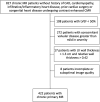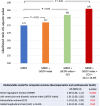Implications of myocardial strain in primary mitral regurgitation-a cardiovascular magnetic resonance study
- PMID: 39295523
- PMCID: PMC11687116
- DOI: 10.1093/ehjci/jeae245
Implications of myocardial strain in primary mitral regurgitation-a cardiovascular magnetic resonance study
Abstract
Aims: Chronic primary mitral regurgitation (MR) results in progressive left ventricular (LV) remodelling. Abnormal myocardial deformation (strain) can be present despite preserved ejection fraction (EF). Cardiovascular magnetic resonance (CMR) feature-tracking techniques allow assessment of global longitudinal strain (GLS) from routine cine images. The aim of this study is to evaluate the prognostic value of CMR feature tracking-derived GLS in patients with primary MR.
Methods and results: Consecutive patients undergoing CMR for chronic MR from January 2012 to June 2018 were enrolled. Patients with LVEF <50% were excluded. The composite primary outcome aiming to detect decompensation related to MR comprised (i) referral for mitral surgery owing to symptoms or LV systolic dysfunction or (ii) cardiovascular death. The secondary outcome was all-cause death. A total of 422 patients were followed for a median of 2.7 years, and the primary endpoint was met in 93 patients (34 patients reported symptoms at baseline). At multivariable analysis, GLS≥ -16.6% was associated with primary outcome [hazard ratio (HR) 1.90, P = 0.01]. In moderate MR cohort, patients with GLS≥ -16.6% had worse event-free survival, whereas there was no significant difference in mild or severe MR groups. GLS≥ -16.0% remained associated with all-cause death after adjusting for other covariates including the MR severity (HR 2.24, P = 0.02).
Conclusion: In patients with primary MR with preserved systolic function, GLS was associated with our composite outcomes and all-cause death. GLS may serve as a marker of cardiac dysfunction in the patients with primary MR with preserved systolic function allowing identification of patients likely to decompensate during observation.
Keywords: cardiovascular magnetic resonance imaging; feature tracking; global longitudinal strain; left ventricular function; mitral regurgitation.
© The Author(s) 2024. Published by Oxford University Press on behalf of the European Society of Cardiology.
Conflict of interest statement
Conflict of interest: None
Figures






References
-
- Enriquez-Sarano M, Akins CW, Vahanian A. Mitral regurgitation. Lancet 2009;373:1382–94. - PubMed
-
- Lung B, Baron G, Butchart EG, Delahaye F, Gohlke-Bärwolf C, Levang OW et al. A prospective survey of patients with valvular heart disease in Europe: the euro heart survey on valvular heart disease. Eur Heart J 2003;24:1231–43. - PubMed
-
- Otto CM, Nishimura RA, Bonow RO, Carabello BA, Erwin JP, Gentile F et al. 2020 ACC/AHA guideline for the management of patients with valvular heart disease: executive summary: a report of the American College of Cardiology/American Heart Association Joint Committee on Clinical Practice Guidelines. Circulation 2021;143:e35–71. - PubMed
-
- Kalam K, Otahal P, Marwick TH. Prognostic implications of global LV dysfunction: a systematic review and meta-analysis of global longitudinal strain and ejection fraction. Heart 2014;100:1673–80. - PubMed
MeSH terms
Grants and funding
LinkOut - more resources
Full Text Sources
Miscellaneous

